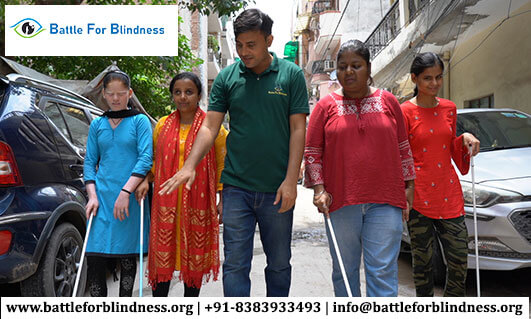
In a world that thrives on visibility, empowerment, and opportunity, the voices of visually impaired girls often remain unheard. Yet, when advocacy and support work together, these girls can break barriers, reach their full potential, and become powerful agents of change in their communities. Advocacy for visually impaired girls is not just about addressing their challenges; it’s about enabling them to shine in a world that is often inaccessible to them.
The Importance of Advocacy for Visually Impaired Girls
Advocacy plays a critical role in transforming the lives of visually impaired girls. With over 39 million blind people worldwide and millions more suffering from low vision, many visually impaired girls are often left behind in terms of education, employment, and social engagement. Advocating for their rights can be a catalyst for change—providing them with the tools, education, and opportunities they need to overcome obstacles.
Empowering advocacy begins by ensuring that visually impaired girls have access to appropriate educational resources, inclusive environments, and a society that values their contributions. It’s about ensuring they have access to:
- Accessible education and resources (Braille, audio materials, assistive technology)
- Equal job opportunities
- Full participation in social and cultural activities
- Support for mental health and emotional well-being
Through advocacy for inclusion, visually impaired girls can break the glass ceiling of discrimination and isolation. It is important to amplify their voices, listen to their unique needs, and ensure they are provided with equitable opportunities for personal growth and societal contribution.
Transformative Effects of Advocacy
Advocacy for visually impaired girls isn’t just about changing policies; it’s about transforming lives. When these girls are provided with the right resources, they experience personal growth that directly impacts their social integration, educational success, and career prospects. Here’s how advocacy has been a game-changer:
Access to Education: One of the most significant barriers faced by visually impaired girls is a lack of accessible education. Advocacy for education ensures that schools and universities are equipped with Braille textbooks, audio resources, and screen readers, allowing visually impaired girls to learn alongside their peers. The availability of inclusive education helps build self-confidence and allows them to pursue their career goals.
Improved Accessibility: Advocacy for accessible infrastructure and technology can significantly enhance the quality of life for visually impaired girls. From accessible transportation systems to technology that helps them navigate their environment, such advancements enable them to move freely and confidently in the world.
Employment Opportunities: Visually impaired girls face systemic challenges when entering the workforce. Advocacy for equal employment opportunities ensures that they are not excluded based on their visual impairments. When employers implement inclusive hiring practices and provide necessary accommodations, visually impaired girls have a chance to contribute meaningfully to the economy.
Raising Awareness: Public awareness campaigns and community-driven advocacy efforts help challenge misconceptions about visual impairments. When society recognizes the potential of visually impaired girls, the stigma surrounding them starts to dissipate. Advocacy for visual impairment can shift societal perceptions and build an inclusive, diverse environment.
Mental Health and Well-Being: Mental health is a crucial aspect of overall well-being, especially for girls with visual impairments. Advocacy that emphasizes mental health support provides these girls with the resources and counseling needed to navigate feelings of isolation, stress, or depression. This fosters resilience and improves their self-esteem.
The Role of Technology in Advocacy
In today’s digital age, assistive technology plays a pivotal role in advocating for visually impaired girls. From screen readers and voice recognition software to smartphone applications that provide navigation assistance, the tools available today help these girls access information, connect with others, and become self-reliant. Digital advocacy campaigns are essential in spreading awareness, providing resources, and creating online communities where visually impaired girls can find support.
By creating online platforms that offer educational resources, social connection, and career development opportunities, advocates can offer a global network of support. Social media campaigns and digital storytelling have proven to be powerful ways to amplify the voices of visually impaired girls, sharing their stories and bringing attention to their needs.
Collaborative Efforts for Lasting Change
The power of collaborative advocacy cannot be overstated. Advocacy efforts for visually impaired girls are most impactful when governments, educational institutions, NGOs, and society work together. Community-driven initiatives, like peer support groups, mentorship programs, and advocacy workshops, are essential in providing the support network that visually impaired girls need to thrive.
How You Can Get Involved
If you are passionate about creating a more inclusive world for visually impaired girls, there are several ways you can contribute:
- Support organizations that advocate for visually impaired girls’ rights and inclusion.
- Volunteer your time to mentor or tutor visually impaired students.
- Promote inclusive practices at schools, workplaces, and public spaces.
- Donate to causes that provide assistive technologies and educational resources to visually impaired girls.
Conclusion
Empowering visually impaired girls through advocacy has the potential to create a world where visibility is not defined by sight alone. Advocacy plays a crucial role in transforming the lives of visually impaired girls, helping them access education, job opportunities, and social inclusion. By collaborating on a global scale, we can break down the barriers that hinder their growth and ensure that these girls are given every chance to succeed.
Together, we can amplify their voices, celebrate their achievements, and create a world where inclusion and empowerment are the foundation for every visually impaired girl’s future.





